The AARG-4i crew in front of the rover. Image courtesy of Dennis Miller.
By Dr. Kristen Miller
Faculty Member, Space Studies
In June 2023, American Public University System’s Analog Research Group (AARG) completed its fourth space analog mission. This mission took place at the Inflatable Lunar-Martian Analog Habitat (ILMAH), owned and operated by the University of North Dakota (UND).
At first, this mission seemed like business as usual. But for the crew of AARG-4i, this ILMAH mission was anything but ordinary.
The AARG-4i crew faced high heat conditions unlike any other previous ILMAH crew while simultaneously navigating higher-fidelity controls and protocols unlike their predecessors. The experiences, challenges and success of the AARG-4i crew paint an intriguing picture of the realities of life in space on Earth.

The AARG-4i crew consisted of three people:
- Commander Dennis Miller, a master’s student in space studies at American Military University (AMU)
- Mission Specialist (MS) Olivia Turner, a master’s student in management at American Public University (APU)
- MS Beau Malnack, a master’s student in space studies at American Military University
Flight director Shae Rackeley (AMU) and deputy flight director Laura Rieske (APU), both master’s students in space studies, led the mission.
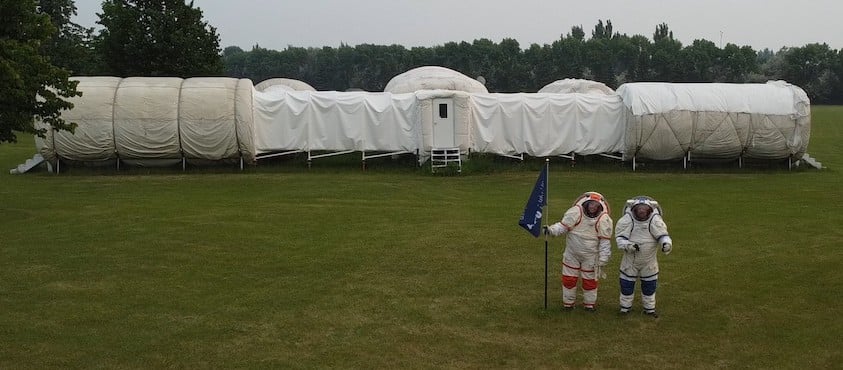
MS Turner and MS Malnack plant the University flag in front of the ILMAH habitat. Image courtesy of Dennis Miller.
Related: Research Explores Using Algae to Grow Plants in Outer Space
Regulating ILMAH’s Temperature Proved Difficult During High Heat Conditions
The crew entered the habitat on June 4. They remained in isolation for 13 days until their exit on June 16.
Due to the possibility of high summer temperatures, ILMAH had never been used during June for any analog missions. But when scheduling constraints forced a June mission, the AARG-4i crew hoped the weather would cooperate. Unfortunately, the habitat area experienced unseasonably high temperatures throughout the entire month.
Temperatures in ILMAH soared during the day, reaching a peak of 89 degrees Fahrenheit in the core module and an unbearable 101degrees in the plant module. However, the AARG-4i crew joked that the high heat inspired the mission motto: ‘Calidum Ad Infernum,’ which roughly translates to “hot as Hades.”
The UND team provided support with portable air conditioning units. The air conditioning lowered the temperatures enough for the crew members to continue the mission.
The AARG-4i crew responded to the high temperatures with determined resilience, maintaining a positive attitude despite the physical discomfort. They rearranged the daily schedule to take advantage of the cooler temperatures during the very early morning.
Mission Specialist Olivia Turner devoted countless hours tending to the plants to keep them alive in spite of the high temperatures. Her efforts were rewarded when the plants grew in two out of three of her experiments.


AARG-4i and Communications with Mission Control
The AARG-4i mission was a Mars simulation, meaning that the crew operated under a 20-minute, one-way communication delay for most of the mission. This communication delay meant that it took at least 40 minutes to receive answers to the crew’s questions as well as information the crew requested.
In addition to the communication delay, all communications were routed through a single point of contact known as mission control (MC). Mission control volunteers were the sole source of information, aid and communication for the AARG-4i crew during the entire mission.
This support was the first time that an AARG crew had been supported by a full mission control staff. The experience was extremely successful.
While the mission control/crew interaction can sometimes be tense and even adversarial, a bond developed between the MC volunteers and the crew members. AARG-4i’s mission control staff were recruited from the UND space studies program; they participated in two hour-long training sessions but otherwise had no prior experience.
The mission control staff’s enthusiasm for their role showed in their reliability and dedication. They quickly and efficiently managed all communications with the AARG-4i crew by answering questions and providing support and requested information. The mission control staff also ensured that daily crew reports were complete and clear.
The mission control staff made a positive difference to the crew’s morale. They shared news trivia, memes, and jokes with the crew, providing much-appreciated levity amidst the challenges of isolation and high temperatures.
Despite the scorching heat they encountered, the crew exemplified unwavering resilience. Their ability to endure and adapt under extreme temperatures is a testament to the strength of human determination and the bond that unites us in the pursuit of exploration.” – Aedanaya Diamond, 4i Mission Control volunteer
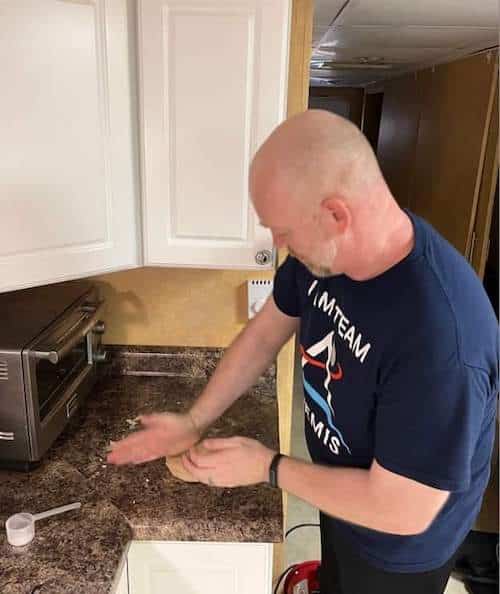

AARG-4i Crew Research Projects Involving Drones and Plants
With the support of mission control, the AARG-4i crew successfully completed research studies involving drone surveillance of the habitat and vascular plant growth. The purpose of the drone project was to determine long-term weathering and wear and tear on an inflatable habitat.
Due to an inability to control conventional drones while wearing spacesuit gloves, MS Malnack used the rover as an observation module to maintain visibility during all drone operations. Visibility proved to be essential and mandatory for all take-off and landing sequences due to atmospheric conditions. Using the rover also provided increased protection for the crew as they operated the high-speed, high-altitude drone.
Using recorded drone footage, MS Malnack found a pattern in exterior damage from UV, wind, and precipitation. This information suggested that a predictable trend in vulnerability can be calculated for maintenance requirements.
Furthermore, the experiment proved that drones can be used during missions to preemptively estimate ILMAH degradation. They can identify vulnerable points on the exterior material of a habitat before rupture or leaking occurs. Also, MS Malnack was able to use good practices and lessons learned in this initial experiment for future studies.
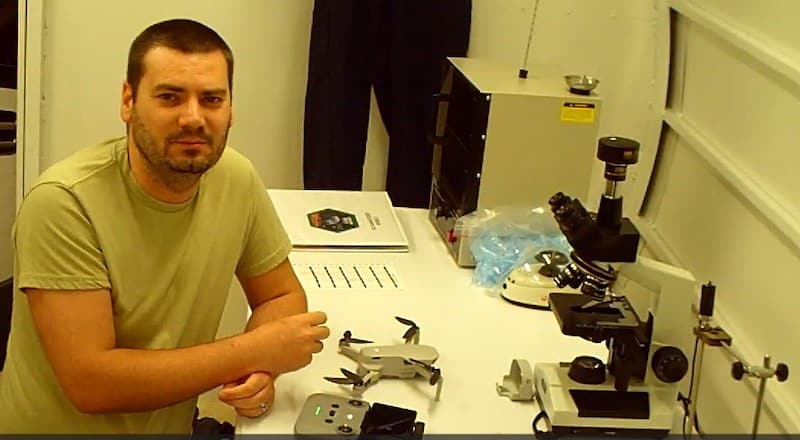
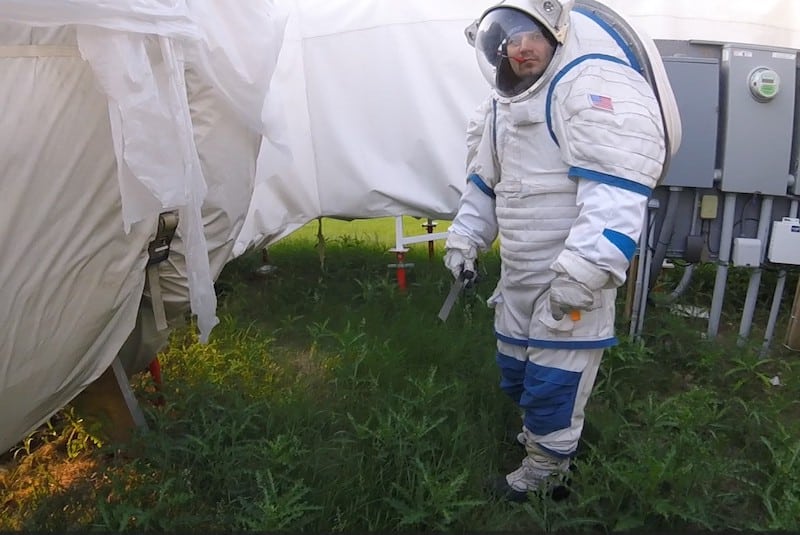
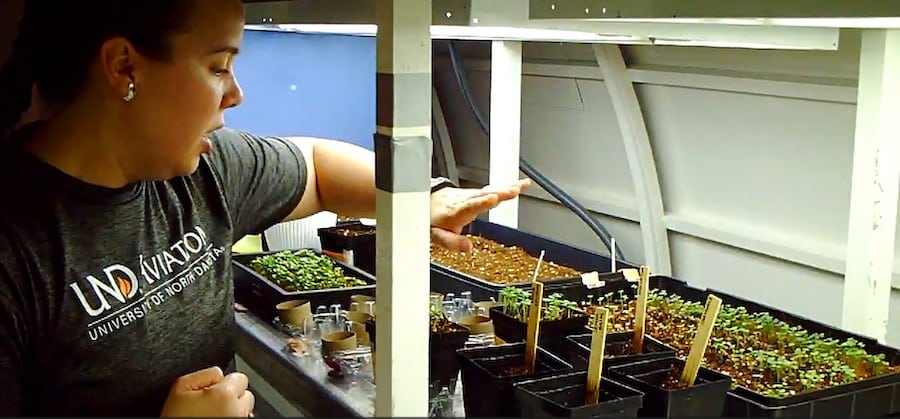
In ILMAH, the AARG-4i crew successfully grew organic, non-GMO (genetically modified) mixed microgreens consisting of mustard, kale red Russian, and arugula. MS Turner sowed the microgreen seeds into three different soils:
- Earth organic blend soil
- Lunar regolith with Earth organic blend soil
- Martian regolith with Earth organic blend soil

She incorporated coconut coir fiber into the soil-regolith mixtures to support water retention and aeration. The groups with soil and with the soil-Lunar regolith both produced useable plants; the soil-Martian regolith did not.
MS Turner found that the highly acidic nature of Martian regolith presented a challenge for growing plants. She plans to resolve this problem with future research.
As the crew commander, CO Miller created the operations order document. This document held the blueprints detailing why and how the crew was to conduct the mission.
The operations order document included:
- The mission statement
- The communication plan
- Risk assessment information
- AARG-4i crew roles and responsibilities
- Other crucial information
Developing such a plan is a vital part of a successful mission. It gives purpose and direction to all stakeholders while remaining flexible and adaptable.
In addition, CO Miller recorded valuable video footage of the habitat, the research, and the EVA and daily debriefing sessions. These videos will serve an important purpose in providing training for future crews.
The ILMAH mission was truly a unique experience that I am thankful for having been a part of. It is humbling to think that I might have played a small but crucial part in the overall advancement of the human race in colonizing Mars.” – Dennis Miller, Commanding Officer
Related: Space Research: AARG Successfully Completes a Third Mission
Coping with Challenging Situations, Planned and Unplanned
No space or space research mission goes exactly as planned; issues frequently arise which test a crew’s problem-solving and teamwork abilities. Coping with challenging situations is especially difficult during isolation and time-delayed communications, which require a higher degree of crew autonomy than normal operating conditions.
In addition to the daily issues that arise in every mission, AARG-4i crew faced two challenging situations: one planned and one unplanned.
The planned situation was a simulation exercise, which was part of the mission’s communications research. This simulation exercise was designed to evaluate the ability of the AARG-4i crew to work both independently and collaboratively with mission control to mitigate a mock emergency involving an oxygen leak in ILMAH.
Prior to the June 2023 mission, the crew and mission control staff were trained in emergency protocols specific to four different simulated emergencies. While they knew that a planned and challenging situation would occur during this fourth mission, they did not know when it would happen or which of the four situations would occur.
The AARG-4i crew successfully completed the exercise of dealing with the “oxygen leak,” working with each other and with mission control staff. The crew worked mostly autonomously, sending reports but not waiting to receive feedback from mission control before proceeding. The time delay with mission control provided strong motivation, and the crew resolved the emergency before it became critical.
The unplanned situation occurred when ILMAH’s communications system, known as ECHO, became overwhelmed by the volume of data exchange. ECHO failed without warning at 8:12 a.m. on Mission Day 10, initiating a no-communication period that lasted for approximately two hours.
The comms blackout induced mild panic in both the AARG-4i crew and mission control staff. The real inability to communicate at all was much more stressful than the simulated oxygen leak.
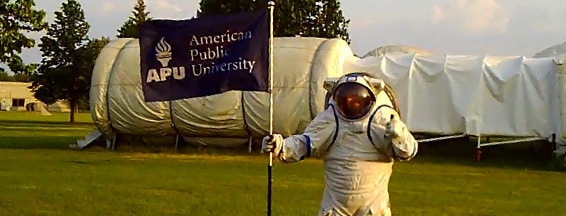
The AARG-4i analog research mission was one of the most challenging that AARG has completed to date. Its success was in the dedication, professionalism, and resolute cheerfulness of the crew, as well as the careful planning by the flight directors and the teamwork between the crew and mission support staff.
About the Author
Dr. Kristen Miller is an associate professor of space studies. She holds a B.S. in physics from Brigham Young University, an M.S. in astrophysics from the University of Maryland, College Park, and a Ph.D. in astrophysics from the University of Maryland, College Park. Her thesis work studied turbulence in magnetic fields in the protostellar disks surrounding young stars using supercomputer simulations, investigating both the ways in which turbulence allows angular momentum transport within the disks and how coupling of the gas to the field influences the direction of the accretion flow onto the protostar.
Currently, Dr. Miller leads the APUS Analog Research Group, which recruits and trains teams of students to participate in analog research missions. She also leads the Supernova Search Program, a group dedicated to detecting supernovae and other transient objects in nearby galaxies.
Dr. Miller is the faculty advisor for the APUS student chapter of the American Institute of Aeronautics and Astronautics (AIAA). She is the co-Editor in Chief of the Space Education and Strategic Applications (SESA) Journal and also serves on a variety of committees at the University.
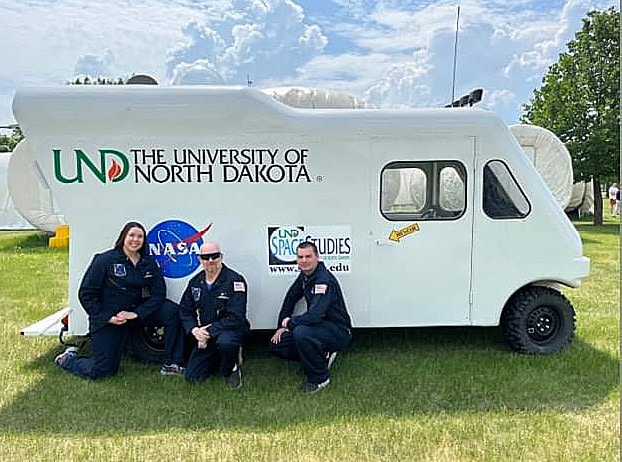
Comments are closed.